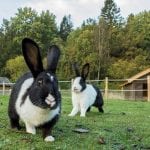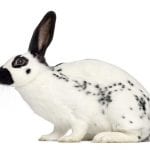Scientific Facts
| Common Name: | French Angora |
| Scientific Name: | Oryctolagus cuniculus |
| Life Span: | 7 to 12 years |
| Size (Adult): | Large |
| Weight (Adult) | 7.5 to 10.5 pounds |
| Habitat: | Human homes, fields, gardens, yards, farms |
| Body Shape: | Commercial |
| Country of Origin: | Turkey |
Physical Description
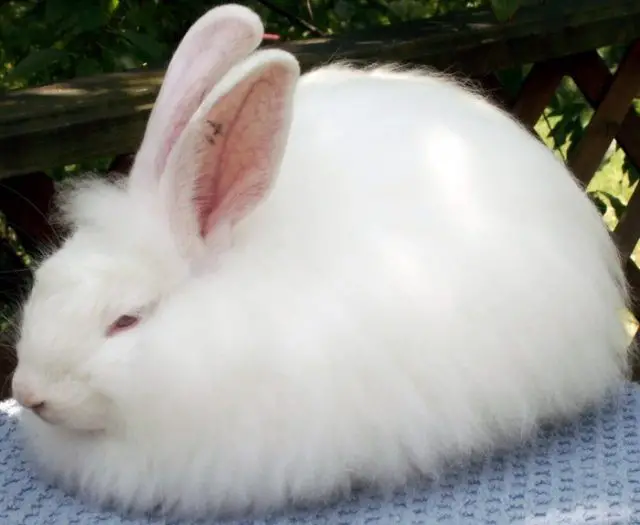
One of the wooliest, cutest and friendliest rabbit breeds is the French Angora. This gentle giant is the star of most rabbit shows and is also an all-around loving pet. The French Angora has a commercial-type body with a strong built, sturdy frame and straight ears.
There are many types of Angora rabbits, but unlike its cousins, the French Angora does not have facial fur. There are some tufts of fur on the rear legs while the rest of its body is covered with coarse guard hairs and crimped underwool strands.
Coat and colors
One of the most common mistakes that people make with a French Angora is that they think that this rabbit is high-maintenance. The truth is, despite its classy appearance, it is very easy to care for, and grooming is not a problem at all.
The coat of an Angora is called wool, and it can be harvested, spun, and made into different articles of clothing like sweaters, scarves, and hats. You need to keep the wool clean and well-brushed if you plan to use its wool, but if not, then regular grooming will do.
The French Angora’s coat can grow up to 6 inches per season, and thus, it needs to be removed once in a while. Shearing is a must and will also make the rabbit more comfortable since it’s hard to move with all that wool!
Now, when it comes to colors, the French Angora has a long list, including markings on the rabbit’s face and body. The Pointed White is a pure white rabbit with marks on the nose, feet, nails, and ears. The Self Group is composed of rabbits with blue and ruby-eyed whites, black (with dark slate wool and brown eyes), blue (are lighter than black and have blue-grey eyes), chocolate (with light brown wool and lovely brown eyes) and the lilacs (with pinky, grey wool and with blue-gray eyes).
Other French Angora color groups include the Agouti Group, which includes chestnut, chocolate agouti, copper, lynx, and opal. The Chinchilla includes the chinchilla, chocolate chinchilla, lilac chinchilla, and squirrel chinchilla.
The Shaded Group includes pearl, seal, sable, smoke pearl, lilac, blue tortoiseshell, tortoiseshell, and chocolate tortoiseshell. The Ticked Group which has blue steel, chocolate steel, steel, and lilac steel. Finally, the Wide Band Group with cream, red, and fawn. Each of these colors has a specific face, legs, and body markings, and eye colors.
History of the Breed
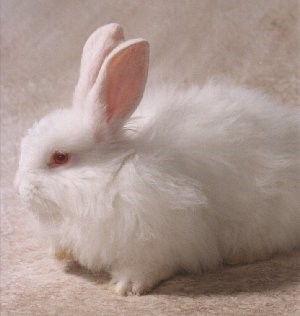
There are five Angora rabbit breeds, and the French Angora is the closest one to resemble the original Angora rabbit from Ankara, Turkey. This ancestral rabbit was brought from Turkey in 1773 to France by sailing ships.
The very first Angora rabbits that were imported to the United States were called the Angora Wooler. Back then, there were no specific features to distinguish different Angoras such as the French, Giant, English, and Satin Angora. It was in 1944 when the American Rabbit Breeders Association created rules on how to distinguish these breeds.
Today, the French Angora is known as the second most popular Angoras, second only to the lovely English Angora.
Fast Facts
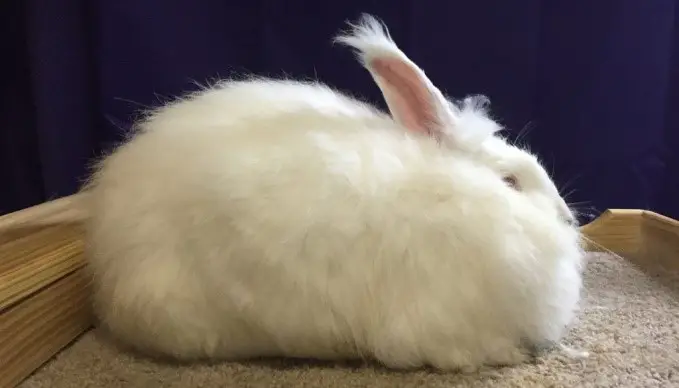
Despite their heavy and luxurious furs, the French Angora can hop and run freely and even very fast. Young French Angoras can hop around and even play with their owners, just like regular rabbits. These are docile and sweet rabbits that love to be the center of attention, too, and they adore grooming, brushing, and styling but not baths.
Reproduction
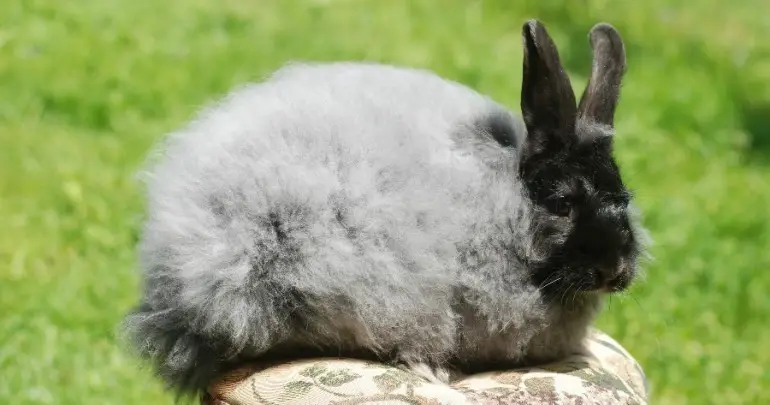
French Angora rabbits are domesticated rabbits and hence, reproduce like one. This breed is forced breed to get baby French Angoras.
Rabbits can breed all year round and may even begin as early as 5 to 8 weeks old. In captivity, the male is placed in his enclosure, and the female is added after a few days. Experts say that this practice can increase guarantee the success of breeding and bearing offspring.
The female will remain still as the male sniffs her from head to tail, but after a short while, she will resist and will escape and run inside the cage. The male will keep up with her and then try to pin her. If she resists for about an hour or so, remove her. Re-introduce the couple after another hour.
The female will soon submit, and she will let the male know by lying down on her side and by allowing the male to sniff and mount her. The mating act is quick, and you’ll know that it is successful when the male leaves the female alone.
The female is removed from the cage and placed in a separate cage where she can rest. The gestation period is usually 38 days long. The female will look for a suitable area to build a nest and will appear restless. She will also refuse to eat and drink and may not be interested in socializing. This is the time to offer a birthing box. Fill this with soft hay so the female can use it as her nest. She may also use other materials nearby to line her nest and also her fur.
The female will soon give birth to three to five babies. A female can become pregnant three to four times a year, depending on environmental conditions. She will nurse her babies and clean these up but soon leave her nest. The babies are left alone blind, deaf, and naked. The mother covers her nest before she leaves and will come back every night to nurse them for only a few minutes. Baby rabbits will open their eyes after 5 to 7 days and wean from their mother at day 10 or 12.
Personality and Behavior

French Angoras are docile and sweet and can be kept indoors or outdoors. These are energetic rabbits and will love to hop around and play with other rabbits, other pets, and their owners. And the more you interact with this breed, the friendlier it gets.
French Angoras will love chewing on anything. If these rabbits are kept indoors, these will chew on anything made of wood and other light materials. Also, it can chew on electrical wiring to avoid accidents, provide hay or chew toys inside the cage. You must also rabbit-proof your home before releasing your pet.
Earning a rabbit’s trust is easy. Use food, treats, and plenty of pats and cuddles. French Angoras love all the attention and will also bond with you if you spend a lot of time grooming and caring for it.
Comparable Breeds
The French Angora is comparable with the Giant Angora rabbit and the English Angora. The Giant Angora is a large breed that can weigh up to 10 pounds. It can live up to 11 years and has a commercial body. This breed is known for its shy and gentle temperament and is for more experienced pet owners.
Meanwhile, the popular English Angora is a small or mini rabbit breed that can weigh up to 6 pounds. It can live up to 12 years and has a curious, calm, gentle, and docile temperament. And because of its many good attributes and its size, it is suitable for people who live in a small space, for families, singles and seniors.
Care of French Angoras

The French Angora is a unique rabbit breed, but caring for this rabbit is like caring for other breeds. Make sure that your pet has the correct rabbit diet, housing or enclosure, the best medical treatment, and has companion rabbits in his enclosure.
An important part of your pet’s daily diet is hay. This is the bulk of a diet aside from rabbit pellets. Commercially-prepared rabbit food has vitamins and minerals for your pet’s good health. Include vegetables and fruits to their meals to create a healthy and well-rounded diet.
Put unlimited fresh water and hay. This is an important part of the rabbit’s diet because this is rough and will help keep their digestive tracts regular. A water bottle with a spout at the end is also a good spill-proof way to drink water. This prevents the rabbit from knocking over the water dish and wetting the enclosure.
Your pet should be eating the right food. Do not feed it produce with pesticides, toxins, and chemicals and feed it only organic fruits and vegetables.
French Angoras may initially be quiet and reserved, but it can become calm and friendly pets if you invest time and effort to train it well. One way it is to regularly interact with your pet rabbit. Take note that rabbits are social animals and will need companions aside from their owners. Rabbits with constant companions and regular interactions with their owners are healthier and happier.
French Angoras are active in the daytime and sleep in the evenings and takes naps in between. Therefore, you must feed your pet in the morning when they are active. Captive rabbits can sleep 8 hours a day and may sleep together to keep themselves warm.
Supplies and Cages
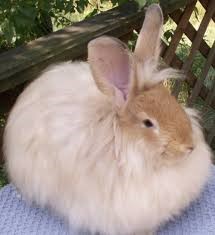
French Angoras can be very energetic, especially young Angoras, and this needs a big enclosure where it can play, sleep, and run together with its cage-mates. This cage must be made of wire with a very strong frame. The bottom should be removable since this is where the rabbit’s droppings will be collected. The floor of the enclosure must have soft bedding or good quality cage bedding.
Use a rabbit hay feeder on the side of the cage. Place hay so your rabbit can eat when it is hungry or when it is boring. For the bedding, you may use hay, wood pellets, or horse bedding. Never use newspapers, paper towels, and brown paper bags because these materials are easy to rip. A newspaper, in particular, has ink that may not be good for pets.
To clean the enclosure, remove your pets and place them in a safe and clean cage. Use a safe cage cleaner or, better yet, use a natural cleaning product such as vinegar, baking soda, or lemon. Do not use household cleaners because these may contain dangerous ingredients that can affect your pet’s health.
If you want to breed rabbits, use a separate or extra cage. Baby rabbits are usually naked, deaf, and blind and thus very vulnerable. You must construct a warm enclosure to keep their bodies at the right temperature. You may use a smaller cage with a cage lamp or lighting to keep the babies dry, warm, and safe from predators.
Health Concerns
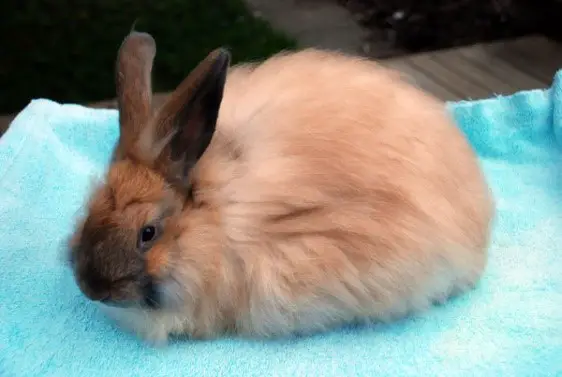
A French Angora is a healthy breed, and these are not affected by any specific disease. However, French Angoras are not immune to common rabbit diseases. This is why you must always monitor your rabbit’s health and temperament. Any kind of change could be due to an illness.
So, as early as your pet opens, its eyes take it to the vet for vaccinations and tests. The vet will recommend tests to assess the health and development of your rabbit. Also, small and younger rabbits have sensitive digestive systems and, therefore, could be prone to enteritis, bloat, and stasis. These are common in rabbits that are less than two months of age.
Check your rabbit for any signs of illness like poor appetite, constipation, diarrhea, and vomiting. Check for an unsteady gait, restlessness, teeth grating, and sleeping for extended periods because these could be a serious condition.
All rabbit breeds should be dewormed at once. Use a pea-sized amount of deworming paste. Put this in the rabbit’s mouth, and this will lick and swallow the medication. You should follow the dose according to your vet’s advice.
Dental Care
A rabbit’s teeth will grow continuously, and sometimes, their teeth can grow to extreme lengths that it can pierce their mouth and gums, causing pain and discomfort. As an owner, make sure that the rabbit’s teeth don’t overgrow to avoid causing a lot of stress. Help your rabbit by offering hay because this can grind the rabbit’s teeth naturally as it chews. You may also pieces of wood, wooden baskets, or other toys and accessories to fill the rabbit’s teeth. Monitor your rabbit’s dental health to save on expensive medical and dental bills.
Spaying or Neutering
Spaying and neutering should be done at a young age. Some vets wait until the rabbits are six months old, while some vets neuter bucks at an early age to reduce aggression. For any question about spaying and neutering, talk to your vet.
Grooming
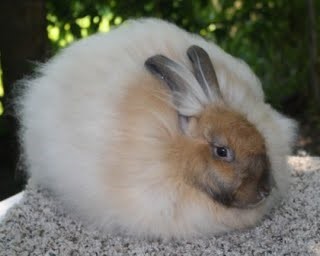
French Angoras are meticulous groomers and will groom themselves to the point that it can take hours to complete. Rabbits also groom each other to bond with other rabbits. French Angoras can take a long time to groom, but it’s easy to do.
Just be patient and use a strong brush. You may also take your pet to the groomer if you want professional styling. Angoras must be sheared at least twice a year. A professional stylist or groomer can also help you with this.
Don’t bath an Angora because this can cause stress. Instead, use a damp towel to spot clean. Don’t forget to trim your rabbit’s nails monthly and check its ears. A groomer can also help you with these.
Availability – Where to Get One?

A French Angora may be bought from a breeder or a retailer. The price will vary, whether it is for pet or show. You can expect the price vary depending on gender, size, coat quality, coat color, markings, and overall appearance.
Searching for a reliable breeder is important. Purchase your French Angoras only from reputable breeders. You can also find this breed in local trade fairs and events as well as in contests sponsored by ARBA.
How to Care for a French Angora
Caring for an Angora is just like caring for other rabbits. Consider the four basic components of rabbit care: a correct diet, housing, companionship, and vet care, and there’s no doubt you’ll be a wonderful pet owner. Captive-bred rabbits like the French Angora can only become a calm, friendly, and docile pet if you take time to train and bond with your pet. Remember, captive rabbits are social animals and will need a rabbit companion or some companions.
And don’t forget to take your pet to the vet early for vaccinations, tests, and physical checks to get a clean bill of health. You need this before you allow the rabbit to socialize with other rabbits and to be handled by family members.
FAQs
What do French Angoras eat?
French Angoras are herbivorous, and this rabbit will eat plants. These will eat roots, bark, seeds, weeds, flowers, and leaves. But in captivity, it will eat commercially-prepared rabbit food, vegetables, seeds, and fruits.
Will French Angoras eat their droppings?
Yes, just like all rabbit breeds, the French Angora will eat its poop because these still have nutrients in them. But after eating this once, they won’t do it the second time.
Can you keep two or more French Angoras inside one cage?
You can keep two or more Angoras in one cage as long as you have a large cage to keep your pets in. The cage should be large, comfortable, and safe.
Can you leave a French Angoras indoors or in your home?
You may let a rabbit stay indoors but only under your constant supervision. Use a portable fence to keep it off areas that you don’t want it to can’t go..
Are French Angoras territorial?
Breeders say that most rabbits may become territorial when these are kept in a small enclosure. Males can develop aggressive behavior during the breeding season. The aggressive males can bite, scratch, and kick other males in the cage for hierarchy.
Will a mother French Angora eat her young?
There are rabbit species that can eat their babies. And if you spot a female Angora eating her young, remove it from the nest and don’t allow it to breed anymore.
Are French Angoras bites dangerous to humans?
Yes, French Angora bites are dangerous because the species may have rabies. Rabbit teeth may be huge, and this can easily tear off skin and flesh and may also infect the wound.
Can French Angoras escape their enclosures?
Yes, French Angoras can escape their cages by kicking it down. These will also use force if necessary to escape.
What happens when the teeth of your pet rabbit grow longer?
When the teeth of the rabbit grow longer, these can pierce its mouth and gums and cause a lot of pain, which may also affect its appetite. You can help it by feeding it hay since this can grind their teeth short as the rabbit chews.
How often does your pet should visit the vet?
Rabbits must visit the vet at least twice a year. Young rabbits should receive vaccinations against diseases as early as possible.
Can rabbit diseases affect humans?
Some rabbit diseases will only affect rabbits, while some are also dangerous to humans. If your rabbit is sick, take it to the vet as soon as you can.
Do French Angoras have good hearing?
Just like most rabbits, the French Angora has good hearing. It can hear its predators from far away, and this allows it time to jump and escape the threat.
Can rabbits see in the dark?
Yes, rabbits have good vision even at night. This is why some species forage for food at night. Rabbits such as the French Angora also have a good smell and hearing to avoid predators.
Where do rabbits sleep in the wild?
In the wild, rabbits can remain in holes or burrows. Rabbits can dig deep holes as deep as several inches to remain inside all day.
Can pet rabbits be patient with young children?
Some rabbits don’t want to be held by young children while some are calm, docile, and friendly and can tolerate even small children.
How young do you spay or neuter a rabbit?
It depends on the vet as to when to neuter a rabbit. Some vets neuter bucks at 3 months while some will wait till these are 5 to 6 months before they spay or neuter.
